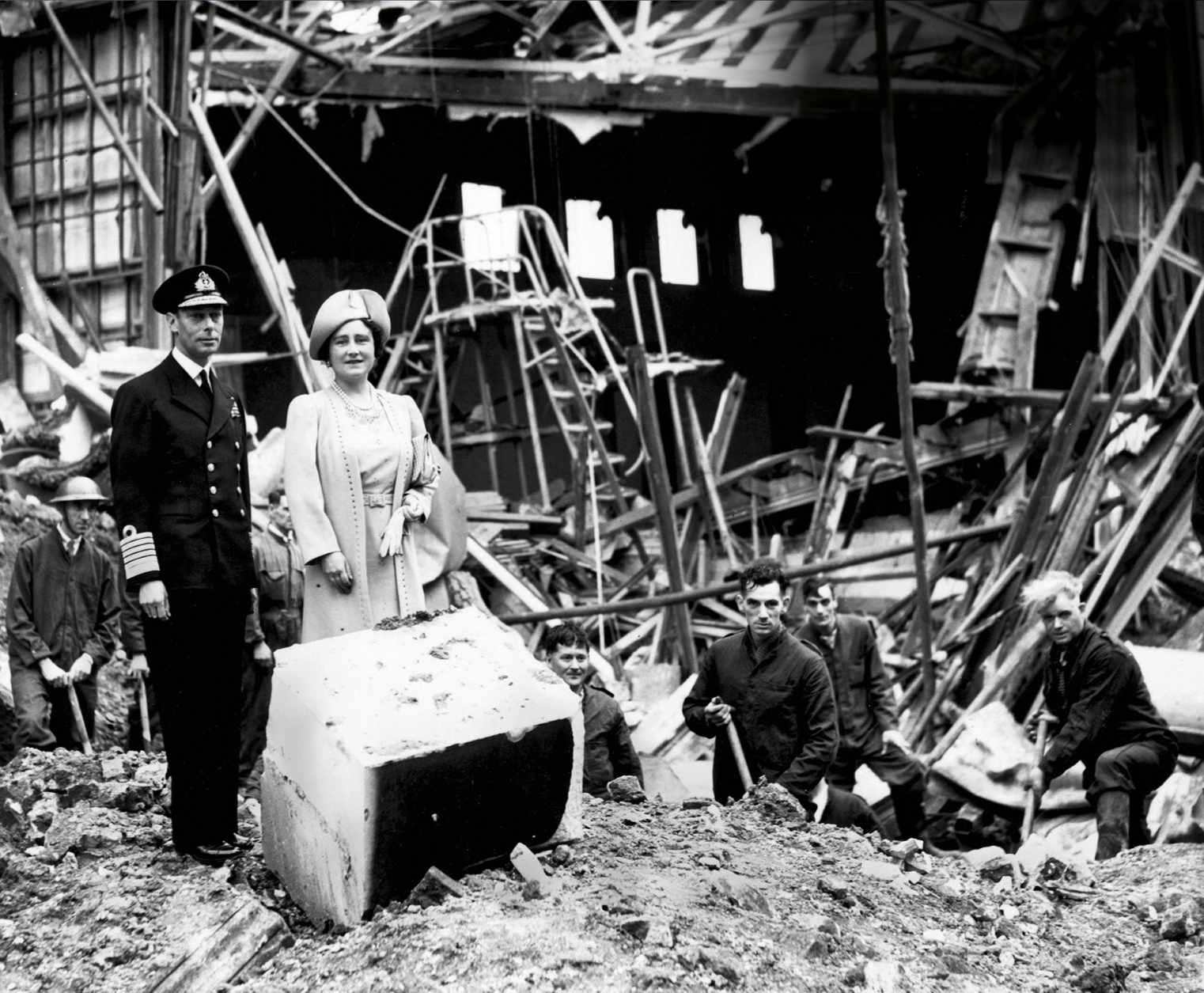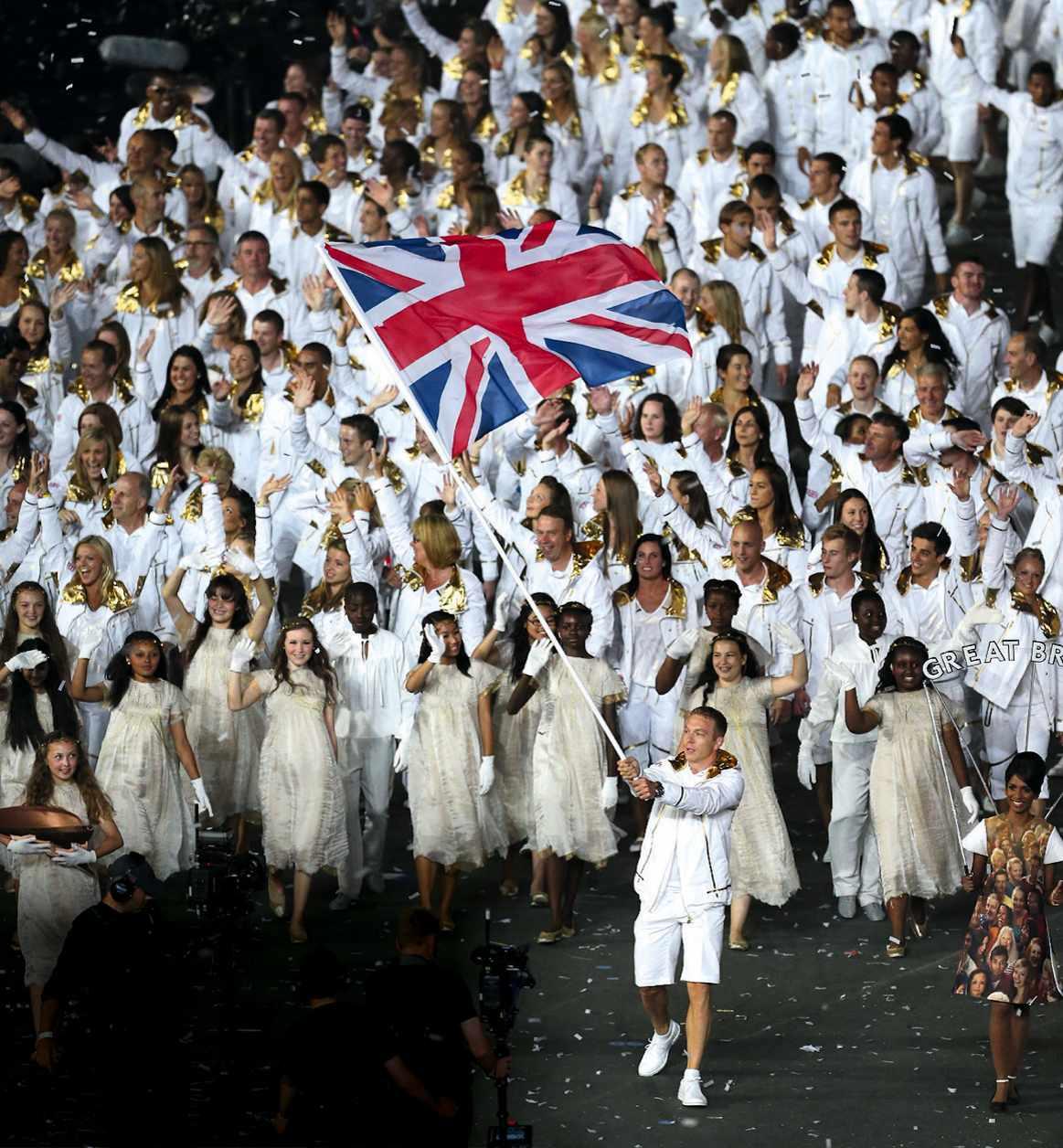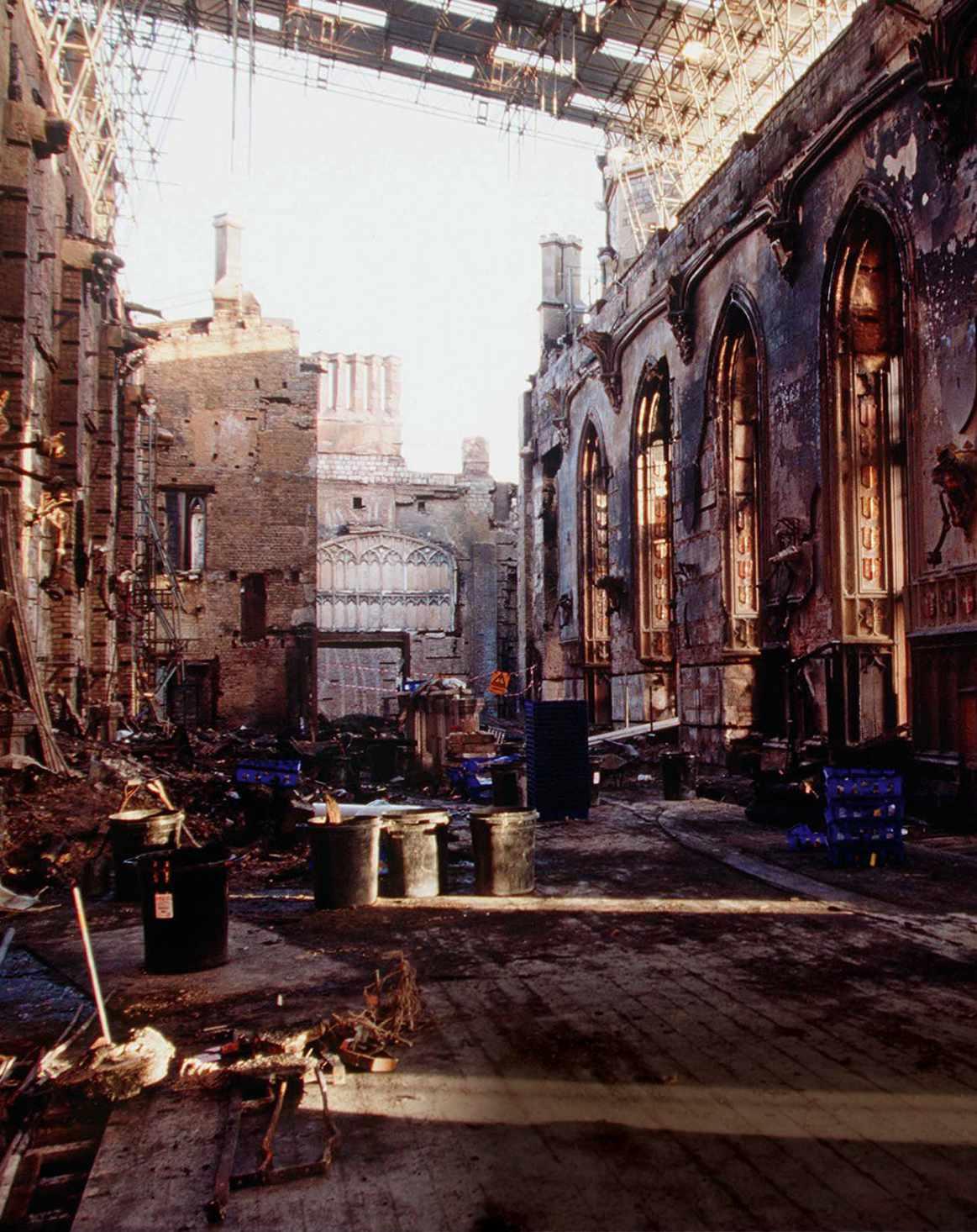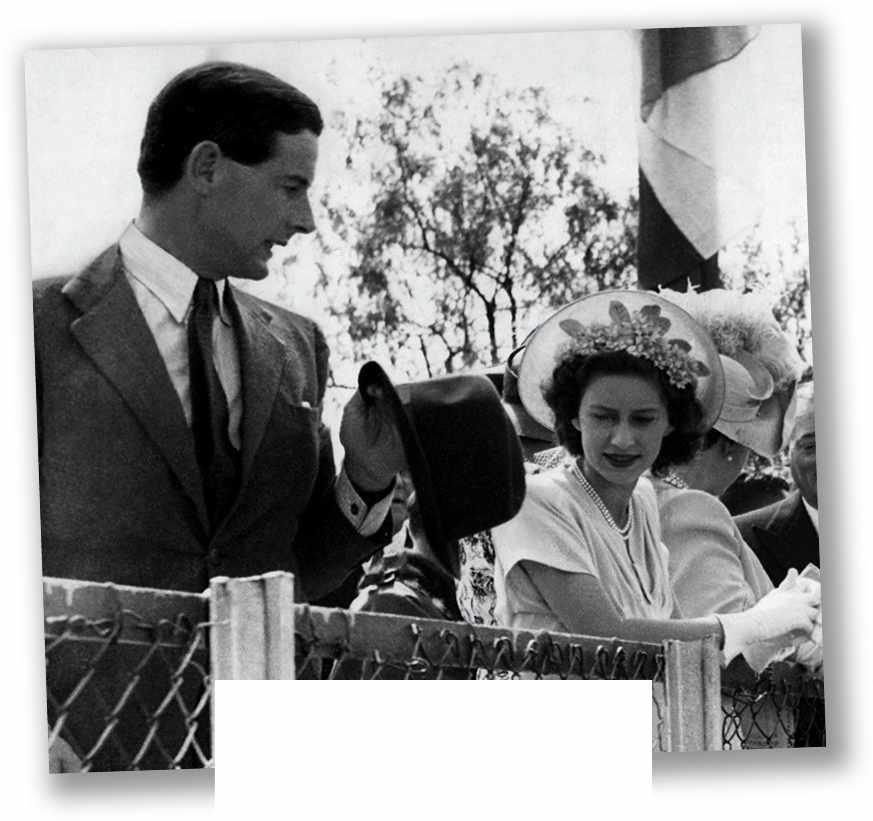
15 minute read
The changing face of the monarchy
MORALE BOOSTER
George VI and Queen Elizabeth (later the Queen Mother) won affection by visiting bomb sites. Buckingham Palace, pictured, was bombed several times
A NATION MOURNS
Profound public shock and grief greeted the news of George VI’s death. Film showings, theatre performances, sports fixtures and broadcasts were cancelled
n the morning of 6 February
O1952, when a BBC radio broadcast announced that King George VI had died overnight in his sleep at Sandringham, men stopped their cars, got out and stood to attention as a mark of respect.
When Sir Edward Ford, the assistant private secretary at
Buckingham Palace, took a taxi round to Downing Street to break the news, the septuagenarian prime minister,
Winston Churchill – who was spending the morning in bed with a cigar while working on state papers – burst into tears and exclaimed: “Bad news? The worst!” There was a sense of genuine national shock. Despite the fact that the king had been seriously ill with cancer for some time and had undergone an operation to remove his diseased left lung a few months earlier, there had been no public admission that he was unwell.
Parliament paid its respects and then adjourned for a fortnight. Theatres and cinemas closed, and radio broadcasts of comedy programmes and the daily soap opera Mrs Dale’s
Diary were suspended. There was at the time just one broadcasting organisation; only half a million households had a television set, and the transmission of (black-and-white) pictures had only recently extended as far as the Midlands.
Britain 70 years ago was a country almost unimaginably different in outlook, attitudes, morals and ethos from today – to say nothing of technology. Opinion polls into the early 1960s showed that just under a third of respondents believed that the Queen had been chosen by God rather than by right of succession from her father.
There was, to be sure, subversive criticism of the monarchy. “I am just absolutely sick of seeing her face on everything from tinned peas upwards,” one member of the public told the Mass Observation social research organisation before the Queen’s coronation in 1953. Yet, in that much more deferential society, even the mildest public criticism was muted. After the journalist and historian John Grigg, himself Baron Altrincham, ventured in a magazine article in 1957 that the Queen sounded like “a priggish schoolgirl, captain of the hockey team”, he was assaulted in the street for his temerity by one Philip Kinghorn Burbidge from the League of Empire Loyalists.
A Mass Observation poll conducted in a working-class part of London in May 1953, a month before the coronation, found more than 70 per cent were pleased or very pleased about the event, and only 14 per cent were hostile. Nearly seven decades later, with polling supposedly more scientific and using a slightly different question, the approval rating remains astonishingly similar: a YouGov poll in the run up to the wedding of Prince Harry and

WAITING PATIENTLY Although millions famously watched the coronation at home on newfangled television sets, in London many people slept in the streets along the procession route to guarantee a view of the sovereign travelling to and from Westminster Abbey

Meghan Markle in May 2018 found seven in ten Britons supported the country continuing to have a monarchy.
However, the optimism that greeted that wedding – interpreted as revealing a developing maturity for the prince and introducing welcome new blood and fresh ideas for the family “firm” – soon faded. By January 2020 the couple had decided to end their active public duties and retreat to North America. There they amplified their grievances in a television interview with Oprah Winfrey in March 2021 – Markle complained of media intrusion and made allegations of racism – which served to cut them off further from the royal family. The couple’s previous good press in Britain was replaced with disappointment, and Prince Harry went down in public estimation: in a 2021 YouGov poll, his popularity was only 31 per cent.
In contrast, Prince William and his family are still held in high regard. According to the same 2021 YouGov poll, William’s popularity is at 72 per cent, second only to the Queen, and the Duchess of Cambridge’s is at 64 per cent – third-highest of the royal family.
Such a consistent approval rating is all the more remarkable because virtually all other institutions have declined in esteem over the past 70 years. Politicians, clergy, bankers, businessmen and journalists are all less trusted, admired and deferred to than they were in the 1950s – an era when, during the 1955 general election campaign, BBC broadcaster Leslie Mitchell concluded an interview with prime minister Sir Anthony Eden with the obsequious words: “May I say thank you very much indeed for letting me question you.”
he reasons for the monarchy’s popu-T larity in 1952 were clear: King George VI and his family had been the nation’s figureheads during the Second World War. If their contribution had been more symbolic than practical, they were credited with sticking with their people and suffering the war’s privations like everyone else. The truth was slightly different: they had received extra coupons
RED BOX DUTY
The Queen makes a point of still dealing with the daily dispatch boxes from government and the Commonwealth

and could retreat to Windsor Castle during the Blitz. However, Buckingham Palace had been bombed while the king and queen were in residence, and they had certainly raised morale through regular visits and public appearances throughout the war.
here was public sympathy with the T young Queen for the sudden loss of her father, respect for the institution she was taking on and confidence in her sense of responsibility. She was clearly not frivolous, as her uncle Edward VIII had been or as her younger sister Princess Margaret was. As the Manchester Guardian pronounced in its editorial, with courtly and patronising charm, on the day she became Queen the throne was as secure “in the love of all who acknowledge allegiance to it as it has ever been in history… It is a great inheritance – and a heavy burden – that now falls to the girl who becomes Queen. All may have confidence that she will wear the crown nobly.”
It is rather difficult to imagine the same newspaper taking the same view next time – its editorial stance has changed somewhat – but, throughout what is now the longest reign in British history, the Queen’s diligence and sense of duty has never wavered, a point appreciated by the majority of the population. They may not think of her every day, and they may not even particularly admire the institution, but she is respected. Not even republican organisations are calling for her abdication or removal.
As one former Labour cabinet minister told me: “The institution is working pretty well, and there are more important issues to be concerned about… There would have to be a compelling reason to make change a priority.
about any issues of the day

UNDER FIRE
The blaze that tore through Windsor Castle in 1992 focused attention on the running costs of the royal family; the Queen subsequently began paying income tax
MASS APPEAL
Cyclist Sir Chris Hoy leads the Great Britain team during the opening ceremony of the 2012 London Olympics, during which the Queen appeared in a crowd-pleasing James Bond skit

And it would be a terrible vote loser.” Even Jeremy Corbyn, the former leader of the Labour Party and a lifelong republican, felt constrained to join the Privy Council of the Queen’s formal advisers, though he drew the line at bending the knee when swearing allegiance as he did so.
he Queen’s long reign exemplifies
Tmany of the lessons the British monarchy has learned, sometimes the hard way, over centuries. Primarily, it has remained above partisan politics: no one really knows what the Queen thinks about any issues of the day, despite periodic attempts to second-guess her views on issues such as the European Union. Her personal life has always been above suspicion: she has maintained the Victorian tradition of family respectability – even though her children have not always been models of propriety themselves. Most notably, Prince Andrew has withdrawn from public duties following public criticism of his association with the disgraced American financier and convicted sex offender Jeffrey Epstein, who hanged himself while awaiting trial on criminal charges in 2019. (The prince denies having knowledge of Epstein’s crimes and any allegations of wrongdoing prompted by his association with Epstein.)
Above all, in her tenth decade the Queen maintains an ostentatious sense of public duty. The red boxes of government papers are dealt with daily. She still undertakes regular official meetings and has weekly formal audiences with the prime minister, but she has given up overseas state visits and cut back on public appearances.
Yet the institution has changed almost out of recognition since 1952: an evolution of style to keep pace with a changing society and public expectations that has gone largely unnoticed. In the early years, the Queen did not do walkabouts; she did not travel by public transport as she occasionally does now; divorced people were generally not introduced at court; members of religious groups other than Anglicans had no official role in her coronation; and she certainly did not appear in television documentaries or spoofs such as the James Bond skit at the opening of the London Olympics in 2012.
The protocols remain much the same, but compromises do much to help humanise the monarchy. For the first 15 years of Elizabeth’s reign the solitary royal press officer, Commander Richard Colville, was known to the press as the “abominable no-man” because of his reluctance to divulge any information whatsoever. Now there is a proactive media operation, a royal website and even a Twitter account for the royal family (though the Queen herself doesn’t actually tweet).
It has not all been smooth sailing. The 1990s, encompassing the highly public break-ups of three of her children’s marriages, the fire at Windsor Castle and the death
GETTY IMAGES ´
SIGN OF THE TIMES
The Duchess and Duke of Cambridge, the Queen, Prince Charles and the Duchess of Cornwall stand socially distanced at Windsor as they express thanks to local volunteers and key workers in December 2020
of Princess Diana, was a rocky period. It produced a greater openness about the royal finances – still not entirely transparent – and the acceptance of paying tax on her personal income, something her predecessors had fought against for 80 years.

t the same time, palace reforms insti-
Atuted a more professional, less wasteful, operation. There are now annual reports on the costs of the monarchy and its official duties, including travel – all designed self-consciously to prove value for money. In 2020–21 the cost of the institution was £87.5m, funded by a core grant of £51.5m to cover maintenance, travel and official duties, with the rest a reservicing grant for extensive renovation work, particularly at the crumbling Buckingham Palace. The annual profit from the historic crown estates, accrued by monarchs over the centuries (139,000 hectares, including chunks of central London, Ascot racecourse, business and retail parks across the country, more than half the UK coastline and estates dotted from the Highlands to Somerset) goes to the government: £345m in 2019–20. In return, the Treasury dispenses 15 per cent of Crown Estates profits to the monarch to meet the costs of royal duties.
Despite accusations of extravagance, mainly directed at offspring such as Prince Andrew rather than at the Queen herself, there is little sign of public disquiet about the costs of royalty. Republicans argue that the figure is underestimated because it does not include the cost of security, though presumably any alternative head of state would also need protection. The Queen’s private wealth, from investments and the profits from the historic 18,454 hectares of the Duchy of Lancaster estates, contribute to an estimated net private worth of approximately £365m, according to the Sunday Times Rich List published in May 2021. That does not make her even one of the 250 wealthiest people in the country.
Now in her nineties, the Queen is almost certainly the most photographed and celebrated woman on the planet, as she has been for at least the past seven decades. She is an immediately recognisable symbol of Britain throughout the rest of the world, as she is through the Commonwealth and the 15 countries of which she is also queen. The House of Windsor’s succession is secured – all being well – for three further generations, stretching quite probably into the next century if her great-grandson lives as long as she has. That is, of course, if her heirs, the future Charles III, William V and George VII, follow her diligent example and do not compromise the reputation of the monarchy. n
QUEEN THE
ABOUT THE AUTHORS
FROM THE MAKERS OF BBC HISTORY MAGAZINE Dickie Arbiter is Queen
EDITORIAL
Editor Rhiannon Davies Editor (BBC History Magazine) Rob Attar Production editors Sue Wingrove and Paul Bloomfield Art editors Rosemary Smith and Sarah Lambert Group art editor Susanne Frank Picture editors Hilary Clothier and Katherine Mitchell Additional work by Ellie Cawthorne, Rachel Dickens, Rachel Dinning, Matt Elton, Elinor Evans, John Evans, Charlotte Hodgman, Paul Jarrold, Emma Mason, Spencer Mizen and Samantha Nott historymagazine@historyextra.com
PRESS AND PUBLIC RELATIONS
PR Manager Natasha Lee Natasha.Lee@immediate.co.uk SYNDICATION
Director of licensing & syndication Tim Hudson International partners’ manager Anna Brown PRODUCTION
Production director Sarah Powell Senior production co-ordinator Lizzie Ayre Reprographics manager Tony Hunt IMMEDIATE MEDIA COMPANY
Content director David Musgrove Commercial director Jemima Dixon Group managing director Chris Kerwin CEO Sean Cornwell Executive chairman Tom Bureau BBC STUDIOS
Managing Director, Consumer Products and Licensing
Stephen Davies Chair, Editorial Review Boards Nicholas Brett Director, Magazines and Consumer Products Mandy Thwaites Compliance manager Cameron McEwan UK publishing co-ordinator Eva Abramik (uk.publishing@bbc.com)
© Immediate Media Company London Limited, 2022 – ISSN: 1469 8552
Not for resale. All rights reserved. Unauthorised reproduction in whole or part is prohibited without written permission. Every effort has been made to secure permission for copyright material. In the event of any material being used inadvertently, or where it proved impossible to trace the copyright owner, acknowledgement will be made in a future issue. MSS, photographs and artwork are accepted on the basis that BBC History Magazine and its agents do not accept liability for loss or damage to same. Views expressed are not necessarily those of the publisher. We abide by IPSO’s rules and regulations. To give feedback about our magazines, please visit immediate.co.uk, email editorialcomplaints@immediate.co.uk or write to Katherine Conlon, Immediate Media Co., Vineyard House, 44 Brook Green, London W6 7BT Immediate Media Company is working to ensure that all of its paper is sourced from well-managed forests. This magazine can be recycled, for use in newspapers and packaging. Please remove any gifts, samples or wrapping and dispose of it at your local collection point.
Cover picture: A colourised version of a studio portrait of Queen Elizabeth II, c1955, Getty Images. Back cover picture: An official portrait of Princess Elizabeth taken shortly before her 21st birthday, April 1947, Getty Images. Elizabeth’s former press secretary, a seasoned television and radio commentator, and author of On Duty with the Queen (Blink, 2014). He looks at life within Buckingham Palace, past and present, on page 52.
Victoria Arbiter is an experienced broadcaster who has served as royal commentator for CBS, ABC and CNN. On page 6 she takes us through milestones in the Queen’s life; on page 28 she joins Elizabeth’s coronation in 1953; and on page 42 she examines the tension between family life and royal duties.
Stephen Bates is a former royal correspondent of The Guardian and author of Royalty Inc: Britain’s BestKnown Brand (Aurum, 2015). On page 64 Stephen looks at public attitudes to the Queen’s jubilees; on page 84 he explores the Queen’s overseas visits; and on page 124 he examines the modernisation of the royal family.
Francis Beckett is a journalist and contemporary historian whose books include biographies of Tony Blair, Gordon Brown, Clement Attlee and Harold Macmillan. On page 76 he describes the relationships Elizabeth II has had with her prime ministers.
Tracy Borman is a historian, author and joint chief curator for Historic Royal Palaces. Her latest book is Crown & Sceptre: A New History of the British Monarchy, William the Conqueror to Elizabeth II (Hodder & Stoughton, 2021). On page 36 she introduces five influential British queens from previous centuries.
Mark Glancy is professor of film history at Queen Mary University of London. His latest book is Cary Grant: The Making of a Hollywood Legend (Oxford University Press, 2020). On page 108 Mark examines three movie portrayals of the Queen. Sarah Gristwood is a broadcaster and author of several historical works, including Elizabeth: The Queen and the Crown (Pavilion, 2017) and The Tudors in Love: The Courtly Code Behind the Last Medieval Dynasty (Oneworld, 2021). On page 20 Sarah looks at the longest marriage in British royal history.
Ashley Jackson is professor of imperial and military history at King’s College London. His books include The British Empire: A Very Short Introduction (OUP, 2013). Ashley considers the Queen’s changing Commonwealth on page 90.
Richard Overy is a historian, author, and honorary professor of history at the University of Exeter. His latest book is Blood and Ruins: The Great Imperial War, 1931–1945 (Allen Lane, 2021). On page 116 he explores the dramatic changes that have swept the world during the Queen’s lifetime.
Ted Powell is a historian, broadcaster and lecturer. His latest book is King Edward VIII: An American Life (OUP, 2018). On page 112 he analyses the popularity and accuracy of the Netflix series The Crown.
Dominic Sandbrook is a historian and broadcaster. His books include Who Dares Wins: Britain, 1979–1982 (Allen Lane, 2019) and Adventures in Time: The Second World War (Particular Books, 2021). He examines how Britain has changed during Elizabeth’s lifetime on page 100.
Kate Williams is professor of public engagement with history at the University of Reading, and an author and broadcaster. Her nine books include Young Elizabeth: The Making of our Queen (Weidenfeld & Nicolson, 2012) and Rival Queens: the Betrayal of Mary Queen of Scots (Hutchinson, 2018). Her article on Elizabeth’s early years is on page 12.










